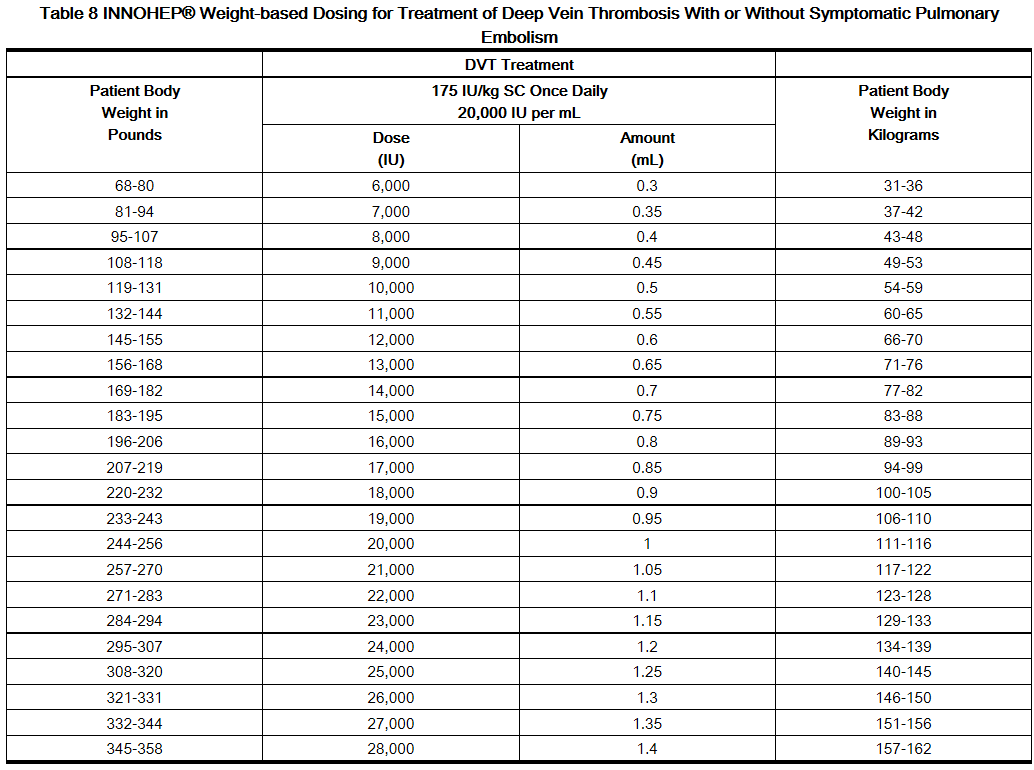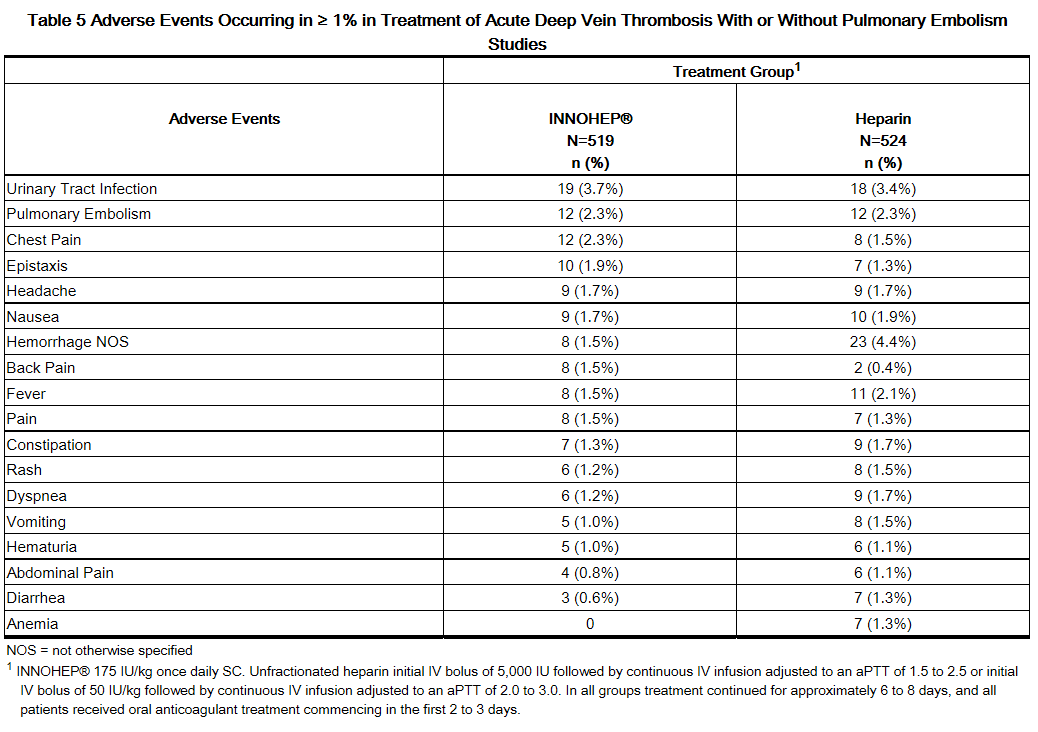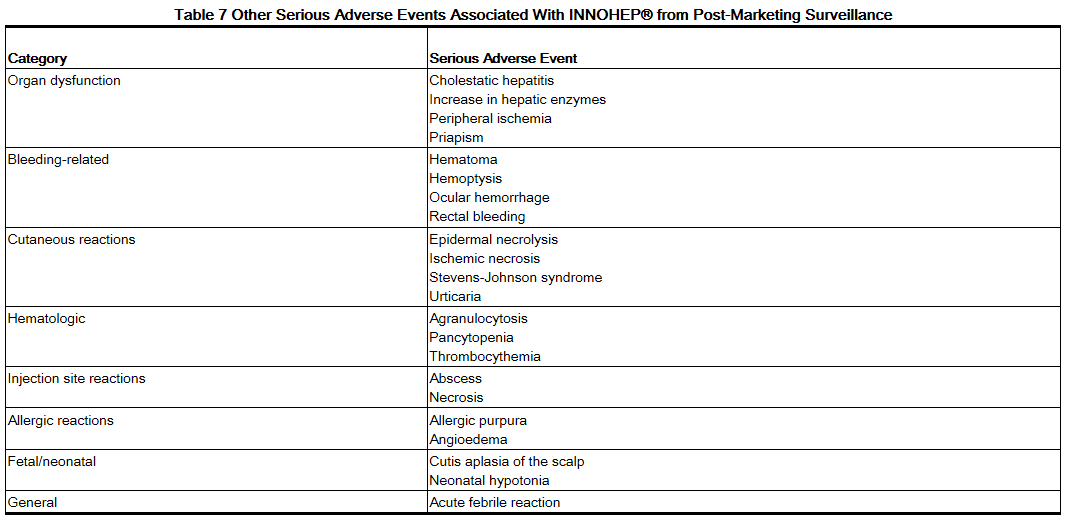Tinzaparin: Difference between revisions
No edit summary |
No edit summary |
||
| Line 124: | Line 124: | ||
[[Image:Tinzaparin Table 6.png|thumb|left|550px]] | [[Image:Tinzaparin Table 6.png|thumb|left|550px]] | ||
{{clr}} | {{clr}} | ||
|postmarketing=[[Image:Tinzaparin Table 7.png|thumb|left|550px]] | |||
[[Image:Tinzaparin Table 7.png|thumb|left|550px]] | |||
{{clr}} | {{clr}} | ||
|drugInteractions=*Because of increased risk of bleeding, INNOHEP® should be used with caution in patients receiving oral anticoagulants, platelet inhibitors (e.g., salicylates, dipyridamole, sulfinpyrazone, dextran, NSAIDs including ketorolac tromethamine, ticlopidine, and clopidogrel), and thrombolytics. | |drugInteractions=*Because of increased risk of bleeding, INNOHEP® should be used with caution in patients receiving oral anticoagulants, platelet inhibitors (e.g., salicylates, dipyridamole, sulfinpyrazone, dextran, NSAIDs including ketorolac tromethamine, ticlopidine, and clopidogrel), and thrombolytics. | ||
Revision as of 16:15, 11 July 2014
Editor-In-Chief: C. Michael Gibson, M.S., M.D. [1]; Associate Editor(s)-in-Chief: Alejandro Lemor, M.D. [2]
Disclaimer
WikiDoc MAKES NO GUARANTEE OF VALIDITY. WikiDoc is not a professional health care provider, nor is it a suitable replacement for a licensed healthcare provider. WikiDoc is intended to be an educational tool, not a tool for any form of healthcare delivery. The educational content on WikiDoc drug pages is based upon the FDA package insert, National Library of Medicine content and practice guidelines / consensus statements. WikiDoc does not promote the administration of any medication or device that is not consistent with its labeling. Please read our full disclaimer here.
Black Box Warning
|
SPINAL/EPIDURAL HEMATOMAS
See full prescribing information for complete Boxed Warning.
Spinal/Epidural Hematomas: Epidural or spinal hematomas may occur in patients who are anticoagulated with low molecular weight heparins (LMWH) or heparinoids and are receiving neuraxial anesthesia or undergoing spinal puncture. These hematomas may result in long-term or permanent paralysis. Consider these risks when scheduling patients for spinal procedures. Factors that can increase the risk of developing epidural or spinal hematomas in these patients include:
Monitor patients frequently for signs and symptoms of neurological impairment. If neurological compromise is noted, urgent treatment is necessary. Consider the benefits and risks before neuraxial intervention in patients anticoagulated or to be anticoagulated for thromboprophylaxis |
Overview
Tinzaparin is a low molecular weight heparin that is FDA approved for the treatment of acute symptomatic deep vein thrombosis with or without pulmonary embolism. There is a Black Box Warning for this drug as shown here. Common adverse reactions include bleeding, erythema, increase liver function tests, neurologic pain.
Adult Indications and Dosage
FDA-Labeled Indications and Dosage (Adult)
Deep Venous Thrombosis
- Dosage Information
- 175 anti-Xa IU/kg SC once daily for at least 6 days
- Warfarin therapy should be initiated within 1-3 days of tinzaparin initiation.
- (100 anti-Xa IU equals 1 mg tinzaparin sodium.)

Off-Label Use and Dosage (Adult)
Guideline-Supported Use
There is limited information regarding Off-Label Guideline-Supported Use of Tinzaparin in adult patients.
Non–Guideline-Supported Use
There is limited information regarding Off-Label Non–Guideline-Supported Use of Tinzaparin in adult patients.
Pediatric Indications and Dosage
FDA-Labeled Indications and Dosage (Pediatric)
There is limited information regarding Tinzaparin FDA-Labeled Indications and Dosage (Pediatric) in the drug label.
Off-Label Use and Dosage (Pediatric)
Guideline-Supported Use
There is limited information regarding Off-Label Guideline-Supported Use of Tinzaparin in pediatric patients.
Non–Guideline-Supported Use
There is limited information regarding Off-Label Non–Guideline-Supported Use of Tinzaparin in pediatric patients.
Contraindications
- Tinzaparin is contraindicated in patients with active major bleeding, in patients with (or history of) heparin-induced thrombocytopenia, or in patients with hypersensitivity to tinzaparin sodium.
- Patients with known hypersensitivity to heparin, sulfites, benzyl alcohol, or pork products should not be treated with tinzaparin.
Warnings
|
SPINAL/EPIDURAL HEMATOMAS
See full prescribing information for complete Boxed Warning.
Spinal/Epidural Hematomas: Epidural or spinal hematomas may occur in patients who are anticoagulated with low molecular weight heparins (LMWH) or heparinoids and are receiving neuraxial anesthesia or undergoing spinal puncture. These hematomas may result in long-term or permanent paralysis. Consider these risks when scheduling patients for spinal procedures. Factors that can increase the risk of developing epidural or spinal hematomas in these patients include:
Monitor patients frequently for signs and symptoms of neurological impairment. If neurological compromise is noted, urgent treatment is necessary. Consider the benefits and risks before neuraxial intervention in patients anticoagulated or to be anticoagulated for thromboprophylaxis |
- Tinzaparin is not intended for intramuscular or intravenous administration.
- Tinzaparin cannot be used interchangeably (unit for unit) with heparin or other low molecular weight heparins as they differ in manufacturing process, molecular weight distribution, anti-Xa and anti-IIa activities, units, and dosage. Each of these medications has its own instructions for use.
- Tinzaparin should not be used in patients with a history of heparin-induced thrombocytopenia.
Increased Risk for Death in Elderly Patients with Renal Insufficiency
- tinzaparin may increase the risk for death, compared to UFH, when administered to elderly patients with renal insufficiency.
- A clinical study compared tinzaparin (175 IU/kg once daily; N = 269) and UFH (N = 268) in the initial treatment of deep vein thrombosis (DVT) and/or pulmonary embolism (PE) in elderly patients with renal insufficiency (i.e., patients aged 70 years or older with estimated creatinine clearance of ≤ 30 mL/min or patients aged 75 years or older with estimated creatinine clearance of ≤ 60 mL/min).
- Oral anticoagulants were co-administered beginning on Days 1-3 and study treatment was continued for at least five days until the international normalized ratio (INR) was between 2-3 on two successive days; oral anticoagulants were then continued alone and patients were followed until 90 days after the start of treatment.
- Overall mortality rates were 6.3% in patients treated with UFH and 11.5% in patients treated with tinzaparin. Consider the use of alternatives to tinzaparin in elderly patients with renal insufficiency.
Hemorrhage
- tinzaparin, like other anticoagulants, should be used with extreme caution in conditions with increased risk of hemorrhage, such as bacterial endocarditis; severe uncontrolled hypertension; congenital or acquired bleeding disorders including hepatic failure and amyloidosis; active ulcerative and angiodysplastic gastrointestinal disease; hemorrhagic stroke; shortly after brain, spinal or ophthalmological surgery, or in patients treated concomitantly with platelet inhibitors.
- Bleeding can occur in any tissue or organ of the body during therapy with tinzaparin. Hemorrhage in some cases has been reported to result in death or permanent disability.
- A hemorrhagic event should be seriously considered in the presence of an unexplained fall in hematocrit, hemoglobin, or blood pressure.
- If severe hemorrhage occurs, tinzaparin should be discontinued.
- Spinal or epidural hematomas can occur with the associated use of low molecular weight heparins or heparinoids and spinal/epidural anesthesia or spinal puncture which can result in long-term or permanent paralysis. The risk of these events is higher with the use of post-operative indwelling epidural catheters or with the concomitant use of additional drugs affecting hemostasis such as NSAIDs.
Thrombocytopenia
- Thrombocytopenia can occur with the administration of tinzaparin.
- In clinical studies, thrombocytopenia (platelet count <100,000/mm3 if baseline value ≥150,000/mm3, ≥50% decline if baseline <150,000/mm3) was identified in 1% of patients given tinzaparin; severe thrombocytopenia (platelet count less than 50,000/mm3) occurred in 0.13%.
- Thrombocytopenia of any degree should be monitored closely.
- If the platelet count falls below 100,000/mm3, tinzaparin should be discontinued. Cases of thrombocytopenia with disseminated thrombosis also have been observed in clinical practice with heparins, and low molecular weight heparins, including tinzaparin sodium. Some of these cases were complicated by organ infarction with secondary organ dysfunction or limb ischemia, and have resulted in death.
Hypersensitivity
- tinzaparin contains sodium metabisulfite, a sulfite that may cause allergic-type reactions including anaphylactic symptoms and life-threatening asthmatic episodes in certain susceptible people.
- The overall prevalence of sulfite sensitivity in the general population is unknown, but is probably low.
- Sulfite sensitivity is more frequent in asthmatic people than in non-asthmatic people.
Priapism
- Priapism has been reported from post-marketing surveillance as a rare occurrence. In some cases surgical intervention was required.
Miscellaneous
- tinzaparin multiple dose vial contains benzyl alcohol as a preservative.
- The administration of medications containing benzyl alcohol as a preservative to premature neonates has been associated with a fatal “Gasping Syndrome."
- Because benzyl alcohol may cross the placenta, tinzaparin preserved with benzyl alcohol should be used with caution in pregnant women only if clearly needed
Adverse Reactions
Clinical Trials Experience
Bleeding
Bleeding is the most common adverse event associated with INNOHEP® (tinzaparin sodium injection); however, the incidence of major bleeding is low. In clinical trials, the definition of major bleeding included bleeding accompanied by ≥2 gram/dL decrease in hemoglobin, requiring transfusion of 2 or more units of blood products, or bleeding which was intracranial, retroperitoneal, or into a major prosthetic joint. The data are provided in Table 4.

Fatal or nonfatal hemorrhage from any tissue or organ can occur. The signs, symptoms, and severity will vary according to the location and degree or extent of the bleeding. Hemorrhagic complications may present as, but are not limited to, paralysis; paresthesia; headache, chest, abdomen, joint, muscle or other pain; dizziness; shortness of breath, difficult breathing or swallowing; swelling; weakness; hypotension, shock, or coma. Therefore, the possibility of hemorrhage should be considered in evaluating the condition of any anticoagulated patient with complaints which do not indicate an obvious diagnosis.
Thrombocytopenia
In clinical studies thrombocytopenia was identified in 1% of patients treated with INNOHEP®. Severe thrombocytopenia (platelet count <50,000/mm3) occurred in 0.13% (see WARNINGS, Thrombocytopenia).
Elevations of Serum Aminotransferases
Asymptomatic increases in aspartate (AST [SGOT]) and/or alanine (ALT [SGPT]) aminotransferase levels greater than 3 times the upper limit of normal of the laboratory reference range have been reported in up to 8.8% and 13% for AST and ALT, respectively, of patients receiving tinzaparin sodium for the treatment of DVT. Similar increases in aminotransferase levels have also been observed in patients and healthy volunteers treated with heparin and other low molecular weight heparins. Such elevations are reversible and are rarely associated with increases in bilirubin (see PRECAUTIONS, Laboratory Tests).
Local Reactions
Mild local irritation, pain, hematoma, and ecchymosis may follow SC injection of INNOHEP®. Injection site hematoma has been reported in approximately 16% of patients treated with INNOHEP®.
Hypersensitivity
Anaphylactic/anaphylactoid reactions may occur in association with INNOHEP® use (see CONTRAINDICATIONS and WARNINGS).
Adverse Events
Adverse events with INNOHEP® or heparin reported at a frequency of ≥1% in clinical trials with patients undergoing treatment for proximal DVT with or without PE, are provided in Table 5.

Other Adverse Events in Completed or Ongoing Trials
Other adverse events reported at a frequency of ≥1% in 4,000 patients who received INNOHEP® in completed or ongoing clinical trials are listed by body system:
- Body as a Whole: injection site hematoma, reaction unclassified.
- Cardiovascular: hypotension, hypertension, tachycardia, angina pectoris.
- Central and Peripheral Nervous System: dizziness.
- Gastrointestinal: flatulence, gastrointestinal disorder (not otherwise specified), dyspepsia.
- Platelet, Bleeding and Clotting Disorders: hematoma, thrombocytopenia.
- Psychiatric: insomnia, confusion.
- Red Blood Cell Disorders: anemia.
- Resistance Mechanism Disorders: healing impaired, infection.
- Respiratory System: pneumonia, respiratory disorder.
- Dermatology: rash erythematous, pruritus, bullous eruption, skin disorder.
- Urinary System: urinary retention, dysuria.
- Vascular (Extracardiac) Disorders: thrombophlebitis deep, thrombophlebitis leg deep.

Postmarketing Experience

Drug Interactions
- Because of increased risk of bleeding, INNOHEP® should be used with caution in patients receiving oral anticoagulants, platelet inhibitors (e.g., salicylates, dipyridamole, sulfinpyrazone, dextran, NSAIDs including ketorolac tromethamine, ticlopidine, and clopidogrel), and thrombolytics.
- If coadministration is essential, close clinical and laboratory monitoring of these patients is advised
Use in Specific Populations
Pregnancy
Pregnancy Category (FDA):
There is no FDA guidance on usage of Tinzaparin in women who are pregnant.
Pregnancy Category (AUS):
There is no Australian Drug Evaluation Committee (ADEC) guidance on usage of Tinzaparin in women who are pregnant.
Labor and Delivery
There is no FDA guidance on use of Tinzaparin during labor and delivery.
Nursing Mothers
There is no FDA guidance on the use of Tinzaparin in women who are nursing.
Pediatric Use
There is no FDA guidance on the use of Tinzaparin in pediatric settings.
Geriatic Use
There is no FDA guidance on the use of Tinzaparin in geriatric settings.
Gender
There is no FDA guidance on the use of Tinzaparin with respect to specific gender populations.
Race
There is no FDA guidance on the use of Tinzaparin with respect to specific racial populations.
Renal Impairment
There is no FDA guidance on the use of Tinzaparin in patients with renal impairment.
Hepatic Impairment
There is no FDA guidance on the use of Tinzaparin in patients with hepatic impairment.
Females of Reproductive Potential and Males
There is no FDA guidance on the use of Tinzaparin in women of reproductive potentials and males.
Immunocompromised Patients
There is no FDA guidance one the use of Tinzaparin in patients who are immunocompromised.
Administration and Monitoring
Administration
There is limited information regarding Tinzaparin Administration in the drug label.
Monitoring
There is limited information regarding Tinzaparin Monitoring in the drug label.
IV Compatibility
There is limited information regarding the compatibility of Tinzaparin and IV administrations.
Overdosage
There is limited information regarding Tinzaparin overdosage. If you suspect drug poisoning or overdose, please contact the National Poison Help hotline (1-800-222-1222) immediately.
Pharmacology
There is limited information regarding Tinzaparin Pharmacology in the drug label.
Mechanism of Action
There is limited information regarding Tinzaparin Mechanism of Action in the drug label.
Structure
There is limited information regarding Tinzaparin Structure in the drug label.
Pharmacodynamics
There is limited information regarding Tinzaparin Pharmacodynamics in the drug label.
Pharmacokinetics
There is limited information regarding Tinzaparin Pharmacokinetics in the drug label.
Nonclinical Toxicology
There is limited information regarding Tinzaparin Nonclinical Toxicology in the drug label.
Clinical Studies
There is limited information regarding Tinzaparin Clinical Studies in the drug label.
How Supplied
There is limited information regarding Tinzaparin How Supplied in the drug label.
Storage
There is limited information regarding Tinzaparin Storage in the drug label.
Images
Drug Images
{{#ask: Page Name::Tinzaparin |?Pill Name |?Drug Name |?Pill Ingred |?Pill Imprint |?Pill Dosage |?Pill Color |?Pill Shape |?Pill Size (mm) |?Pill Scoring |?NDC |?Drug Author |format=template |template=DrugPageImages |mainlabel=- |sort=Pill Name }}
Package and Label Display Panel
{{#ask: Label Page::Tinzaparin |?Label Name |format=template |template=DrugLabelImages |mainlabel=- |sort=Label Page }}
Patient Counseling Information
There is limited information regarding Tinzaparin Patient Counseling Information in the drug label.
Precautions with Alcohol
Alcohol-Tinzaparin interaction has not been established. Talk to your doctor about the effects of taking alcohol with this medication.
Brand Names
There is limited information regarding Tinzaparin Brand Names in the drug label.
Look-Alike Drug Names
There is limited information regarding Tinzaparin Look-Alike Drug Names in the drug label.
Drug Shortage Status
Price
References
The contents of this FDA label are provided by the National Library of Medicine.
| Clinical data | |
|---|---|
| ATC code | |
| Identifiers | |
| CAS Number | |
| E number | {{#property:P628}} |
| ECHA InfoCard | {{#property:P2566}}Lua error in Module:EditAtWikidata at line 36: attempt to index field 'wikibase' (a nil value). |
|
WikiDoc Resources for Tinzaparin |
|
Articles |
|---|
|
Most recent articles on Tinzaparin |
|
Media |
|
Evidence Based Medicine |
|
Clinical Trials |
|
Ongoing Trials on Tinzaparin at Clinical Trials.gov Clinical Trials on Tinzaparin at Google
|
|
Guidelines / Policies / Govt |
|
US National Guidelines Clearinghouse on Tinzaparin
|
|
Books |
|
News |
|
Commentary |
|
Definitions |
|
Patient Resources / Community |
|
Patient resources on Tinzaparin Discussion groups on Tinzaparin Patient Handouts on Tinzaparin Directions to Hospitals Treating Tinzaparin Risk calculators and risk factors for Tinzaparin
|
|
Healthcare Provider Resources |
|
Causes & Risk Factors for Tinzaparin |
|
Continuing Medical Education (CME) |
|
International |
|
|
|
Business |
|
Experimental / Informatics |
Editor-In-Chief: C. Michael Gibson, M.S., M.D. [3]
- Pages with script errors
- E number from Wikidata
- ECHA InfoCard ID from Wikidata
- Infobox drug articles without a structure image
- Articles without EBI source
- Chemical pages without ChemSpiderID
- Chemical pages without DrugBank identifier
- Articles without KEGG source
- Articles without InChI source
- Articles without UNII source
- Drugs with no legal status
- Articles containing unverified chemical infoboxes
- Drugs